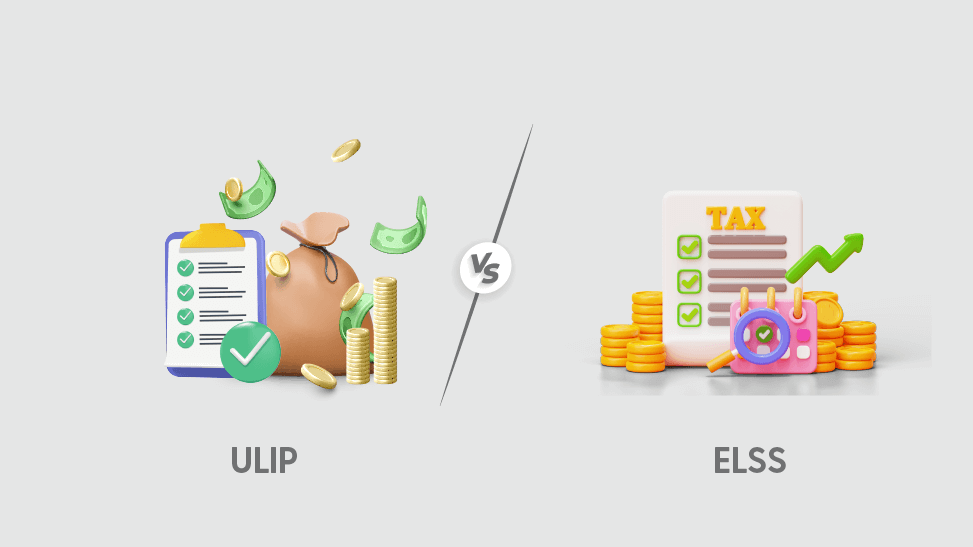- Home
- Blog
- Mutual Funds
- ULIP vs ELSS - Know The Key Difference
- ULIP vs ELSS - Know The Key Difference
ULIP vs ELSS - Know The Key Difference

- Published Date: June 26, 2024
- Updated Date: December 03, 2025
- By Team Choice
When it comes to tax-saving investments in India, two popular Mutual fund options often compared are ULIPs and ELSS mutual funds. In this blog, we’ll break down what each product means, highlight the difference between ELSS and ULIP, compare their returns, and help you understand ELSS vs ULIP: which is better for your financial goals.
What Is a ULIP?
A ULIP (Unit Linked Insurance Plan) is a hybrid financial product that combines life insurance with market-linked investment. A portion of your premium goes toward providing life cover, while the remaining amount is invested in market-linked funds such as equity, debt, or hybrid funds.
What Is ELSS?
ELSS mutual funds are equity-focused tax-saving funds with a short lock-in and strong wealth-creation potential.
Difference Between ELSS and ULIP: A Clear Comparison
Let’s understand ULIP vs ELSS with the help of this table:
| Aspect | ULIP (Unit Linked Insurance Plan) | ELSS (Equity Linked Savings Scheme) |
|---|---|---|
| Purpose | Insurance + Investment in one product | Pure investment for wealth creation |
| Regulating Body | IRDAI (Insurance Regulatory and Development Authority of India) | SEBI (Securities and Exchange Board of India) |
| Lock-in Period | 5 years | 3 years (shortest among 80C investments) |
| Liquidity After Lock-in | Partial withdrawals allowed after 5 years (policy conditions apply) | Redeem fully or partially anytime after 3 years |
| Investment Structure | You receive units; each unit has a daily NAV, just like mutual funds | You receive units of the mutual fund; NAV updated daily |
| Charges | Multiple charges: Premium Allocation, Fund Management, Policy Administration, Mortality Charges | One primary charge: Expense Ratio, already reflected in NAV |
| Cost Transparency | Lower transparency due to multiple deductions | High transparency; single, visible cost |
| Flexibility | Can switch between equity, debt, and hybrid funds | No switching; fixed to the chosen mutual fund |
| Return Potential | Market-linked; returns reduced by multiple charges | Historically higher due to pure equity focus and low costs |
| Tax Benefit (Investments) | Eligible under Section 80C (up to ₹1.5 lakh) | Eligible under Section 80C (up to ₹1.5 lakh) |
| Tax on Maturity / Redemption | Tax-free under Section 10(10D) ONLY if annual premium ≤ ₹2.5 lakh in any year. If premium > ₹2.5 lakh → maturity becomes taxable | LTCG up to ₹1.25 lakh exempt; gains above this taxed at 12.5% + cess (no indexation) |
| Ideal For | Investors wanting insurance + investment in a disciplined long-term plan | Investors focused purely on wealth creation with transparency and lower cost |
| Holding Requirement | A Demat account is not required; it is held as an Insurance Policy | Demat/Trading account is not required (units held in Statement of Account/Folio); can be held in Demat form |
Features of ULIPs:
- Dual Purpose: Insurance + investment in one product
- Lock-in: 5 years
- Regulated by: Insurance Regulatory and Development Authority of India (IRDAI)
- Fund Choices: Equity, debt, and hybrid funds with the flexibility to switch
- Partial Withdrawal: Allowed after the 5-year lock-in period (subject to policy conditions). This gives you limited liquidity if you need funds during emergencies.
- Valuation: Your investment grows through units, and the value of each unit is the Net Asset Value (NAV). NAV reflects the daily market value of the investments, similar to what you see in mutual funds.
Features of ELSS:
- Investment Focus: Equity-oriented mutual fund (80%+ in equities)
- Lock-in: 3 years, the shortest among all Section 80C investments
Note: For SIPs, the lock-in applies to each SIP installment separately.
- Regulated by: SEBI (Securities and Exchange Board of India)
- Structure: Transparent, low-cost structure (only an Expense Ratio, which is factored into the daily NAV)
- Deduction: Eligible for Section 80C deduction (up to ₹1.5 lakh).
Taxation on ULIP:
ULIP taxation has changed in recent years, especially regarding tax-free maturity. Here’s a quick, simplified breakdown:
1. Section 80C Deduction: Premiums paid toward ULIPs qualify for deduction under Section 80C (up to ₹1.5 lakh), shared with other 80C investments like ELSS, PPF, and EPF.
2. Tax-Free Maturity - New ₹2.5 Lakh Premium Limit: ULIP maturity is tax-free under Section 10(10D) only if: Annual premium (across all ULIPs) does NOT exceed ₹2.5 lakh in any policy year. If the premium crosses ₹2.5 lakh, the maturity proceeds become taxable.
3. If Premium Exceeds ₹2.5 Lakh: ULIP gains are taxed like equity-oriented capital gains:
- STCG (≤1 year): 15%
- LTCG (>1 year): 12.5% + cess with no indexation benefits
This reduces the tax advantage of high-premium ULIPs.
4. Death Benefit: The death payout is always tax-free, regardless of the premium amount.
5. Surrender or Partial Withdrawal:
- Surrender before 5 years: The policy is terminated. Any tax benefits claimed under Section 80C previously are reversed (added back to your income and taxed).
- Surrender after 5 years: The proceeds are taxed based on the premium threshold rule (tax-free if the premium is ₹2.5 lakh, taxable otherwise).
- Partial Withdrawal: Generally tax-free after the 5-year lock-in, subject to policy limits (usually a maximum of 10-25% of the fund value).
Understanding ULIP Charges: ULIPs include several charges that impact your overall returns. The major ones are:
- Premium Allocation Charges: Deducted upfront before your money gets invested.
- Fund Management Charges: Charged daily for managing your chosen fund.
- Policy Administration Charges: Recurring charges for policy maintenance.
- Mortality Charges: The cost of providing the life insurance cover, which increases with age.
—> Think of ULIPs like buying a combo meal, you pay for convenience, but each item has a cost built into the final price. These charges reduce the amount that actually gets invested, which is why ULIP returns may be lower than ELSS in many cases.
Taxation for ELSS:
As per the latest rules (effective for transfers on or after July 23, 2024):
- LTCG up to ₹1.25 lakh per financial year → Exempt
- Gains above ₹1.25 lakh → Taxed at 12.5% + cess
- No indexation benefits apply
- Dividends received from ELSS funds are taxed as per the investor's personal income tax slab.
So the tax benefit is: Section 80C deduction (up to ₹1.5 lakh) + LTCG tax at 12.5% on gains exceeding ₹1.25 lakh.
ELSS is ideal for investors focused purely on wealth creation with transparency and the shortest 80C lock-in.
Which Is Better: ELSS or ULIP?
The better choice between ELSS and ULIP depends entirely on your financial goals, your comfort with managing separate products, and how much flexibility or discipline you prefer in your investment journey.
If your primary aim is long-term wealth creation with transparency and lower costs, ELSS generally works better.
- It functions like a vehicle designed purely for performance.
- There is no insurance component bundled with it, the charges are minimal, and the equity exposure allows your investment to grow efficiently over the long term.
- The three-year lock-in is also the shortest among all 80C options, making it suitable for investors who want both tax savings and flexible investment planning.
- For those who already have term insurance or prefer keeping insurance and investment separate, ELSS is typically the more efficient and straightforward choice.
ULIPs, on the other hand, appeal to investors who prefer the convenience of combining insurance and investment in one product.
- They provide a long-term structure that encourages disciplined investing, and the option to switch between equity, debt, and hybrid funds offers additional flexibility.
- However, ULIPs come with multiple charges that affect overall returns, and tax-free maturity is available only when the annual premium does not exceed ₹2.5 lakh in any policy year.
- ULIPs make sense for individuals who consciously want a bundled solution and are comfortable with the fact that the investment portion may deliver lower returns compared to ELSS due to the associated charges.
In practical terms, ELSS is generally better for investors whose primary focus is wealth creation. ULIPs fit better for those who want insurance and investment together and value long-term discipline, even if it comes at a higher cost.
The simplest way to decide is this: if growth and transparency matter most, ELSS is the better option. If you prefer a combined, long-term plan that includes insurance and investment in a single product, ULIP may suit you, provided the premium remains within the tax-beneficial limits.
Conclusion
ULIPs and ELSS both help you save tax and invest for the future, but they serve different financial needs. Your choice should depend on your goals, risk appetite, and whether you prefer a simple investment product or a combined insurance-investment option. For most market-focused investors looking for strong returns, ELSS mutual funds remain a more efficient and transparent choice.
Recommended for you

Copper Price Forecast for Next Week

Indian Stock Market Prediction For Next Week

FII DII Data - Live Data
